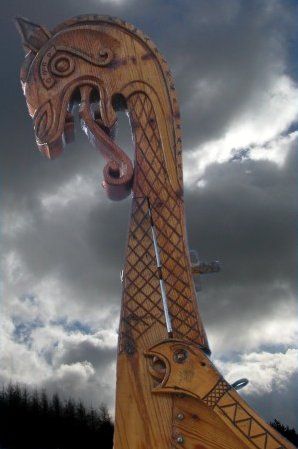 A map of the expanse of the Hanseatic League, mostly known as Hansa (copyright: W. Heinemann / Bibliographisches Institut Leipzig). The Hanseatic League was a large commercial and also politico-military confederation of merchant guilds and commercial towns in North and Central Europe.
A map of the expanse of the Hanseatic League, mostly known as Hansa (copyright: W. Heinemann / Bibliographisches Institut Leipzig). The Hanseatic League was a large commercial and also politico-military confederation of merchant guilds and commercial towns in North and Central Europe.
More
Expanse of the Hanseatic League
05/05/2020
Uncategorized Baltic Sea, Denmark, Germany, Hansa, Hanseatic League, Military, Military history, Military topics, naval history, Naval warfare, Navy, Netherlands, Poland, Scandinavia, Sweden Leave a comment
How contemporary conflicts resemble the medieval wars in Scandinavian areas
12/08/2019
Uncategorized Denmark, Iceland, Medieval, medieval warfare, modern warfare, Nordic, Norway, Scandinavia, Scandinavian, Sweden, University of Oslo, Warfare Leave a comment
Republication from www.hf.uio.no ( University of Oslo)
 “King Sverre’s march over the Vosse mountains” by Peter Nicolai Arbo (1862). Sverre was King of Norway from 1184 to 1202. Picture: Wikimedia Commons
“King Sverre’s march over the Vosse mountains” by Peter Nicolai Arbo (1862). Sverre was King of Norway from 1184 to 1202. Picture: Wikimedia Commons
.
There are many ways in which to understand the new wars of today. One way is to look at the wars that took place in medieval times.
Most wars since 1989 have not been fought between states. The divisions associated with classical types of warfare – between soldiers and civilians, soldiers and criminals, war and peace – are not that clear anymore. Such as the present situation in Afghanistan.
In recent years, there has been a major international discussion among political scientists and anthropologists about how to understand new types of wars that have arisen since the Cold War.
The classical understanding of the term “civil war” is often imprecise when wars are fought across national borders. Instead, the term “new wars” has become more common among many experts and researchers.
The Growth of the Swedish empire
08/07/2019
Uncategorized Denmark, Europe, European Union, Finland, Military, Military history, Military topics, Norway, Poland, Scandinavia, Sweden, Swedish Leave a comment
This is an interesting map on the Growth of the Swedish empire in 1560-1660. Acquisitions are noted in accordance with the reigns of the respective Swedish kings. Note that in 1560 the Kingdom of Sweden had already
More
Half the population of the Viking-town Sigtuna were migrants
08/04/2019
Uncategorized Denmark, medieval warfare, Nordic, Scandinavia, Sigtuna, Sweden, Viking, Viking Age, Viking era, Viking history, Vikings Leave a comment
Republication from Stockholm University
New analysis of the remains of 38 people who lived and died in the town of Sigtuna during the 10th, 11th and 12th century reveals high genetic variation and a wide scale migration. The study is the largest of its kind so far in Sweden and a combination of several methods, including DNA analysis and Strontium isotope analysis of teeth. The results are published in a new article in Current Biology.
Sigtuna is well known as one of the earliest actual cities in the area and was formally founded around 980 AD. More unknown is the fact that the picturesque town, which today is home to around 10 000 people, was a distinctly cosmopolitan place back then.
Beginnings of the Viking peoples: The Scandinavian peoples and tribes from the Vendel Period to the Viking Age
11/10/2016
Uncategorized Denmark, helmet, medieval warfare, Military history, Norway, Scandinavia, Sweden, Sword, Vendel, Viking, Vikings 1 Comment
By Periklis Deligiannis
Dragonhead on the prow of a Viking longship.
.
The historical districts of Scandinavia. The following probable tribal districts are noted among others: Uppland (political center of the Svears) including Vendel site, Ostergotland, Vastergotland, Smaland (small territories of other Gott/Gotar tribes), Gotland Isle (land of the Vagoth or Gutar), Oland isle (land of the Vagoth?), Hordaland (land of the Aerothi?), Ringerike (land of the Ragnaricii), Rogaland (land of the Rugii), Vestfold and Viken (main lands of the Raumarike/Raumaricii), Bohuslan (land of the Wulfings?), Halland (land of the Hallin), Blekinge (land of the Bergio?), Skane and Sjaelland (core territories of the Danes), Angel (cradle of the Angles), Jylland (land of the Jutes), Rugen island (probably colonised by the Rugii), Nordfrisien (North Frisia).
.
The Vendel Culture period of the history of eastern and southern Scandinavia (including Jutland and the Danish isles) is the era before the classic Viking Age. The Viking Age lasted from AD 793 to the early 11th century, while the Vendel Era lasted from the mid-6th century AD to the end of the 8th century and is characterized by princely burials of warlords and warriors with impressive weapons. The later historical period and the homonym cultural conglomerate (Vendel Culture) took their name from the site Vendel at the historical district Uppland in eastern Sweden, north of Old Uppsala, the ancient centre of the Svear kings. The most characteristic cemeteries were found there. It seems that Uppland – where later the important cities of the Viking age Uppsala and Sigtuna were developed – was very important politically during the Vendel period. The area was rather the political center of the tribe of the Svears (Latin: Suiri and Suirones and according to Jordanes: Suehans, Nordic: Svear, Anglo-Saxon: Sweonas, modern Swedes) who expanded to it earlier coming from Svealand, their core territory in the south. Uppland means the upper land, the land in the north.










